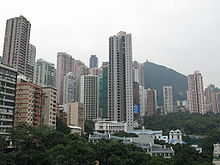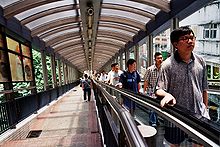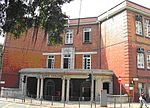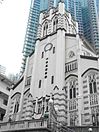- Mid-Levels
-
Mid-levels (Traditional Chinese: 半山區 jyutping: bun3 saan1 keoi1, literally half mountain area) is an expensive residential area on Hong Kong Island in Hong Kong. It is located halfway up Victoria Peak, directly above Central. Residents are mostly local and expat professionals.
The Mid-levels is bound by Bonham Road, Caine Road, Upper Albert Road, Kennedy Road to the north, and Conduit Road to the south. In the west it extends as far as Hong Kong University, and in the east to the south of Wan Chai. It is mainly divided into East Mid-levels above Admiralty, Central Mid-levels above Central and Sheung Wan, and West Mid-levels above Sai Ying Pun. Many streets are named after former Governors of Hong Kong. Examples include Bonham Road (after George Bonham, 1848-1854) and Kennedy Road (after Arthur Edward Kennedy, 1872-1877). Many of the roads in this area are within walking distance of the Central Business District, which is accessible by the mid levels escalator from Central.
Aside from the panoramic view of Victoria Harbour from Mid-levels, it is also close to Central and Admiralty, which are both significant business areas, thus providing easy and convenient access for the business people living in Mid-levels.
An added attraction of the Mid-levels is its close proximity to nature and a comparatively better air quality than many parts of Hong Kong Island. Many wealthy people in Hong Kong are willing to pay top market price for a residency that is away from pollution and yet so close to the centre of the city.
Many choices for housing are available, from luxurious to small and compact apartments. The costs of these apartments vary considerably according to the size, location and age of the building. The cost ranges from a few million dollars to about two hundred million Hong Kong dollars.
Many prestigious colleges and schools can be found in Mid-Levels, the most historical and famous schools being probably The University of Hong Kong, King's College and St. Joseph's College.
The Central-Mid-levels Escalator
Main article: Central-Mid-Levels escalatorsThe Central-Mid-levels escalator cuts through the Mid-levels, from Central to Conduit Road. It allows people to travel quickly between these two places, compared with travelling by the winding roads up the mountain.
At 800 m, it is the longest outdoor escalator in the world. It was opened on 15 October 1994. The escalator runs downhill from 6 am to 10 am and uphill from 10:30 am to midnight everyday. Pedestrians travelling in the opposite direction make use of the adjacent stairs and footpaths. Apart from its transportation function, it is a tourist attraction.
Recreation
Hong Kong Park
Main article: Hong Kong ParkHong Kong Park, which is 80,000 m2 in area, is located next to Cotton Tree Drive in Central. There are modern facilities surrounded by a natural landscape.
Hong Kong Zoological and Botanical Gardens
Main article: Hong Kong Zoological and Botanical GardensThe Hong Kong Zoological and Botanical Gardens is one of the oldest Zoological and Botanical centres in the world. It is located on the northern slope of Victoria Peak and has been opened to the public since 1862. In 1871, itwas officially renamed to Botanical Gardens, and in 1975, the name was changed again to Hong Kong Zoological and Botanical Gardens. This venerable park was previously named Bing Tao Garden, meaning the Chief Commander's Garden. It was then linked to the garden of the Government House. In 1958, a bronze statue of King George VI was erected in the garden to mark the centenary year in which Hong Kong became a British Colony.
Keeping wild animals in the Garden can be traced as early as 1876. At that time, animals were kept merely for entertainment. From 1970s, the emphasis changed to techniques in captive breeding and conservation breeding programmes for zoological collection. Today, the Garden has a collection of over 600 birds, 70 mammals and 40 reptiles which are housed in about 40 enclosures. The collection includes orangutans, gibbons and other primates; the American Flamingo, jaguar and Burmese Python can be found here as well. There is an active breeding programme for many of these species, notably the orangutans, gibbons, and lemurs which rarely breed in captivity.
The Garden keeps for more than 1000 species of inland plant such as Conifer, Fig, Palm, Gum Trees and Magnolia. Besides, a Greenhouse at the eastern boundary of the Garden houses over 150 native and exotic species including orchids, ferns, bromeliads, climbers and house plants etc.
Lung Fu Shan Country Park
Main article: Lung Fu Shan Country ParkLung Fu Shan Country Park covers the densely vegetated slopes of Lung Fu Shan, including the disused Pinewood Battery and the Pinewood Garden picnic area, providing a scenic backdrop to the residential and commercial districts of Hong Kong Island. It is situated at the north of Pok Fu Lam Country Park. Towards the east of Lung Fu Shan Country Park is Hatton Road, to the south is Harlech Road whereas to the north and west is a covered conduit constructed by the Water Supplies Department. This country park covers an area of about 470,000 m² and also commands an excellent vista of the western part of the territory and the Victoria Harbour.
Wan Chai Nature Trail
Wan Chai Nature Trail is a short footpath and it only takes about 2 hours to complete. Along the way, one can gain knowledge about nature, mainly concerning biological, geological and geographical aspects.
Art and culture
The Flagstaff House Museum
Main article: Flagstaff House Museum of Tea WareFlagstaff House Museum of Tea Ware (茶具文物館), a branch museum of the Hong Kong Museum of Art, is located at the Hong Kong Park. The building was built in the 1840s, and originally served as the office and residence of the Commander of the British Forces in Hong Kong. It was converted to the Museum of Tea Ware in 1984, with a new wing, the K.S. Lo Gallery), constructed in 1995.
Flagstaff House Museum of Tea Ware specializes in the collection, study and display of tea ware. The museum promotes Chinese tea drinking culture through many exhibitions. There are video programmes and audio guides conducted in Cantonese and Japanese, regular presentations and lecture programmes, and free guided tours for the visiting tourists.
The Chinese Teahouse, which is a part of the museum, holds serving tea demonstrations regularly.
Hong Kong Visual Arts Centre
Main article: Hong Kong Visual Arts CentreThe Hong Kong Visual Arts Centre is located at Kennedy Road in Central, with the main aim of supporting local art creation. The centre was restructured from an early 20th century building (Cassels Block, former barracks for married British officers) in order to provide an arena and facilities for local artists.
The University Museum and Art Gallery, The University of Hong Kong (UMAG)
Main article: University Museum and Art GalleryThe UMAG is located inside the University of Hong Kong, with an aim to promote Chinese art and culture to college students and the entire community. The UMAG usually holds some exhibitions and art educational activities in order to promote the art education in Hong Kong. The museum is located in the Fung Ping Shan Building, which is situated next to the main entrance of the university. In addition, the Art Gallery is located in the three lower stories of the T T Tsui Building.
Kom Tong Hall
The Dr. Sun Yat-sen Museum is located in the Kom Tong Hall, an old mansion in Castle Road. It contains exhibitions on the life of Dr. Sun Yat-sen and history of the building.
Previously the Church of Jesus Christ of Latter-day Saints owned the Kom Tong Hall. The building was converted to a church building on the lower floors and served as an office for the Asia Area on the upper floors. It was then donated back to the government of Hong Kong.[1] The building was replaced by the church in June 2005 with the newly constructed Wan Chi Church Building on Gloucester Road in Wan Chai.[2]
During World War II this building was supposedly used as the Japanese Headquarters in Hong Kong.
Education
Many schools and colleges can be found in the Mid-levels. The most famous is the University of Hong Kong. Other famous secondary schools such as King's College are also located here.
St. Margaret's Girls' College H.K.
St. Margaret's Girls' College H.K. is a girls college in Hong Kong. It was founded in 1964.
St. Paul's College
St. Paul's College is the oldest school in Hong Kong. It was established in 1851 and celebrated its 155th anniversary in 2006. It was located on Government hill until the end of World War II. It was then relocated to Pok Fu Lam for a few years and moved to Bonham Road in 1950. During those periods, St. Paul's College was merged with St. Paul's Girl's School and formed St. Paul's Co-educational College.
Island School
The flagship ESF school is located on Borrett Road and schools many of the expatriate children living in Mid-Levels. In recent years more and more locals have begun to fill up the school. Island School consistently sends its students to some of the top universities in both the US and UK including Oxford University, LSE, Columbia University, University of Pennsylvania, and University of Michigan.
The Main Building of the University of Hong Kong
The Main Building of the University of Hong Kong is the oldest of all the university's structures. Donated by Sir H.N. Mody, this building's construction began in 1910 and was completed in 1912 at Pok Fu Lam Road. It is made of red bricks and granite and a four turrets with a central clock tower. The clock tower was donated by Sir Paul Chater.[1] The central Great Hall of Main Building is named after the wealthy businessman Lok Yew. During the Second World War, the entire building was damaged but was later repaired. In 1952, two more courtyards were built south to the building and an additional one was completed in 1958. At present, the building houses various departments of the Arts Faculty.
Hung Hing Ying Building, The University of Hong Kong
In 1919, Sir Paul Chater and Professor G P Jordan donated money for the construction of the building, which is named as Hung Hing Ying Building, is located near the Main Building of the University of Hong Kong. This building was designed to house the student union. After the Second World War, it became the Administrative Building. In 1960, the east wing was added and it was made to the Senior Common Room for Staff in 1974. The name of the building remains unchanged until today and it houses the Department of Music at the present.
Old Hall, The University of Hong Kong
Old Hall is used to be a residence hall for students. It is divided into three blocks: Lugard Hall, Eliot Hall and May Hall, which were built in 1913, 1914 and 1915 respectively. All buildings were made of red-bricks, three-storey high, with interconnecting stairs and corridors. The University combined the three halls and renamed it Old Halls in 1969. The Lugard Hall was demolished in 1991, the Eliot Hall became the Administrative Building and the May Hall is used as Office for General Education Unit.
St. Paul's Co-educational College
Main article: St. Paul's Co-educational CollegeSt. Paul's Co-ed. had its first premises at Caine Road in 1915, and moved to the current site at Macdonnell Road in 1925. It was founded as St. Paul's Girls' College, and was converted into co-educational after the Second World War, and was the first co-educational secondary school in Hong Kong. Dr Catherine Woo Building of the campus was the only portion built in 1925, before subsequent expansions took place.
King's College
King's College was built as Sai Ying Pun School in 1879 at the corner of Bonham Road and Western Street. The British used the school as the quarters and hospital for the British Shanghai Defence Force soon after it opened. In 1928, it was reverted to a school but was turned into a stable in 1941 by the Japanese. It became a school again in 1950 and it remains a Government School since then. The building is constructed of red bricks and has three wings: east, south and north.
St. Joseph's College
Main article: St. Joseph's College, Hong KongEstablished in 1875, St. Joseph's College (SJC, 聖若瑟書院) is the first Catholic boys' secondary school in Hong Kong. It is located at 7 Kennedy Road, Mid-levels, in the Central and Western District.
The College is a Lasallian institution. Together with a kindergarten and a primary school, St. Joseph's Primary School, both situated at 48 Wood Road, Wan Chai, the St. Joseph's (the "Schools") population now exceeds 4200.
The Schools provide education which focuses not only on academic but also extracurricular activities. The Schools also emphasise students' social development, with a number of graduates becoming important social figures, for example Charles K. Kao, the winner of 2009 Nobel Prize in Physics.
The north and west blocks of the College are declared monuments of Hong Kong since August 2000.
Houses of worship
Temples
Man Mo Temple is a popular site of worship that is important to Hong Kong culture. The Man Mo Temple was founded in the 1850s at the start of British Occupation of Hong Kong and contains a copper bell made during the reign of the Chinese Emperor Daoguang (1820 - 1850). Man Mo Temple is located at the intersection of Hollywood Road and Ladder Street which is in the area known as Tai Ping Shan rather than the Mid-levels. In addition, there are many small traditional shrines, often adjacent to old large strangler Fig trees.
St John's Cathedral
St John's Cathedral, an Anglican / Episcopalian church located on Garden Road, is one of the oldest and most active places of worship in Hong Kong. It hosts a counselling service, an HIV centre and two advisory centres for migrant workers who form about 5% of Hong Kong's population. St John's operates an "open altar" policy of welcoming to Holy Communion all Christians in good standing. It is also interesting to note that Hong Kong's lands have a set period of grant on them, St John's Cathedral's land is the only exception.
Roman Catholic Cathedral
The Immaculate Conception Cathedral is a Roman Catholic cathedral in Hong Kong located at 16 Caine Road. The first Roman Catholic cathedral of Hong Kong was built in 1843 and destroyed in a fire in 1859. The Cathedral was designed by Crawlwey and Company of London. Construction of the new one started in 1883 and the first Mass was celebrated on 7 December 1888.
Union Church Hong Kong
Union Church Hong Kong is located at Kennedy Road in Mid-Levels, up the hill from Central and Admiralty, and next to where the Peak Tram bridge intersects with Kennedy Road. It is an international, interdenominational church which was established in 1844. The first Union Church was built in 1845 on Hollywood Road. And then, in 1866, the Church relocated to a new site on Staunton Street. Until 1888, due to the church on the Staunton Street had become very crowded, it was moved to the current site on Kennedy Road. Union Church has a long history and during World War II, it was forced to be closed owing to the invasion of the Japanese.
Religious Society of Friends (Quakers)
The Religious Society of Friends (Quakers) has a long connection with China and Hong Kong.
Hop Yat Church
The church was founded in 1862 and located at No.2 Bonham Road. Hop Yat Church was formerly the Daoji Mission House. The union of all Christians in Mainland China made them established the Chinese Church in 1920. A new church was completed and named Hop Yat Church in 1926. The exterior wall has a memorial stone with an inscription of the year 1924.
Jamiah Masjid Mosque
An elegant old Mosque dating from the early days of Hong Kong's history is located on the corner of Mosque Street and Shelley Street. It is easily accessible by the mid-levels escalator.
Ohel Leah Synagogue and Jewish Cultural Centre, Robinson Road
The Ohel Leah Synagogue is a beautiful Synagogue dating from 1901 located on Robinson Road.
Private housing
39 Conduit Road is a residential property developed by Henderson Land Development. Soon after the development was launched in October 2009, the developer claimed to have sold a five bedroom duplex flat, on the "68th floor" of the 46-storey the building for HK$439 million (US$57m). The price, equating to US$9,200 per square foot, set the new world record for the most expensive apartment.[2]
History
The first houses in Mid-Levels were often large mansions, with gardens built out on terraces on the steep hillside. and most had names, such as "Rose Hill" and "Cringleford", and "Idlewild".[3]
Coordinates: 22°16′57″N 114°08′33″E / 22.28262°N 114.14261°E
See also
- List of buildings, sites and areas in Hong Kong
References
- ^ documentary about Sir Paul Chater, directed by Henrik Terchonian
- ^ "Most expensive apartment-Hong Kong flat sets world record". World Records Academy. 21 October 2009. http://www.worldrecordsacademy.org/business/most_expensive_apartment-Hong_Kong_flat_sets_world_record_90382.htm.
- ^ Public Records Office, Map series 1901
External links
Categories:- Places in Hong Kong
- Mid-levels
Wikimedia Foundation. 2010.






